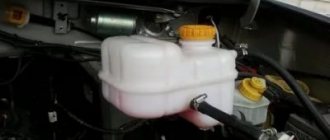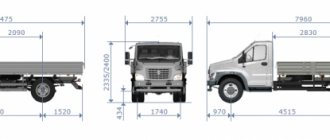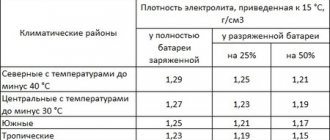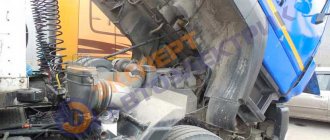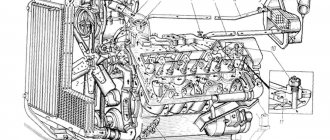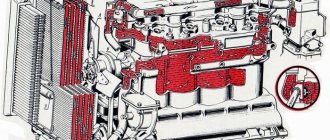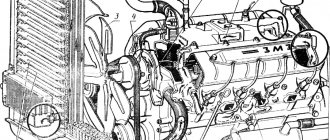UAZ "Bukhanka" is an all-wheel drive off-road vehicle. This model has been produced at the Ulyanovsk Automobile Plant since 1957. This machine is used not only for its intended purpose, after all, it is a special equipment, but it is also used by fishing and hunting enthusiasts.
The main advantage of this car is its versatility and enormous off-road capabilities. The cabin can accommodate 10 passengers, and if necessary, it can be transformed as desired. The heart of the car is the ZMZ-402 and ZMZ-409 engines. Since the car is special, many are interested in how the cooling system of the UAZ “Loaf” works.
General device
These cargo-passenger cars with carriage layout use closed-type liquid cooling. The coolant circulates in the system forcibly under the influence of a centrifugal pump. The manufacturer recommends using domestic Tosol as coolant. However, in emergency cases, you can fill the cooling system of the UAZ “Loaf” with ordinary water. The volume, including not only the cooling system circuits, but also the heater, on most models ranges from 13.2 to 15.3 liters.
Conclusion
The cooling system of the 402 motor is simple and has only basic elements. Therefore, it is quite easy to repair this unit with your own hands, which is what most car enthusiasts do. The cooling system includes the following elements: radiator, fan, water pump, thermostat, expansion tank, pipes, water jacket and heating system.
UAZ "Bukhanka" is an all-wheel drive off-road vehicle. This model has been produced at the Ulyanovsk Automobile Plant since 1957. This machine is used not only for its intended purpose, after all, it is a special equipment, but it is also used by fishing and hunting enthusiasts.
The main advantage of this car is its versatility and enormous off-road capabilities. The cabin can accommodate 10 passengers, and if necessary, it can be transformed as desired. The heart of the car is the ZMZ-402 and ZMZ-409 engines. Since the car is special, many are interested in how the cooling system of the UAZ “Loaf” works.
Cooling system diagram for ZMZ-402
It's quite simple. This power unit is cooled by liquid that passes through two circuits.
The system is built according to a ring scheme and consists of several main components. The liquid moves from the radiator through the pipes to the thermostat, then passes through the engine cooling jacket. Then, through the water pump, it returns to the radiator. In addition, the cooling system of the UAZ “Loaf” with a 402 engine includes an electric fan, a temperature sensor, and heaters. Let's look at each element separately.
Resource
The 402 Gazelle engine will need repairs no sooner than after 200 thousand kilometers. For a commercial vehicle this is not a long time. The motor can be overhauled up to four times. And so that the Gazelle engine does not need repairs for a long time, you need to change the oil in it on time and not overheat the engine.
You should also set the correct ignition. On a Gazelle with a 402 engine, it is installed on the distributor. Adjusting the ignition timing will save the valves from burning out and increase the engine's throttle response.
Thermostat
This is the most delicate component in the system. It fails most often - modern spare parts are not of very high quality. The function of the thermostat is to control the flow of coolant through the engine. The ZMZ-402 unit, like many others, has two coolant circulation circles - large and, accordingly, small.
When the driver starts the engine and it warms up a little, the liquid in the cooling system of the UAZ “Loaf” circulates only in a small circle. This allows the engine to warm up faster. When the temperature reaches approximately 70 degrees, the thermostat will work and coolant will flow through the cooling radiator in a large circle. Operating temperatures for the 402 engine range from 82 to 90 degrees. If the engine does not warm up to these temperatures, this indicates that the thermostat is faulty. Often, due to wear, it jams and does not open.
Specifications
So, ZMZ-402 is a gasoline inline four-cylinder engine with a displacement of 2440 cubic centimeters. The unit has a simple carburetor power system with a mechanical fuel pump.
The timing system is eight-valve, with a chain drive from the crankshaft. The 402 Gazelle engine has a 92 mm piston stroke. The cylinder diameter is also 92 millimeters, which is why the engine had a low compression ratio. Normally, this parameter was 8.2 kilograms per cubic centimeter. An indicator of 6.7 kilograms was considered critical. Along with the low compression ratio, the 402 Gazelle engine was characterized by low power. The maximum power, which was achieved at 4.5 thousand revolutions, was 100 horsepower. Torque – 182 Nm at 2.5 thousand rpm. And if this parameter was still sufficient for the Volga, then for the Gazelle it is no longer there. The car was sensitive to the slightest overload. Eight-degree climbs seemed like a real challenge for her. The oil recommended by the manufacturer is 5w30-15w40. When replacing, you need to pour up to six liters. The oil change schedule is ten thousand kilometers. But motorists recommend doing this earlier, at eight thousand.
Radiator and cooling fan
When the liquid in the cooling system of the UAZ “Loaf” passes through the engine, it will heat up. It must cool down to cool. A radiator is used for this. On these cars, the manufacturer installs mainly copper 3-row radiators. However, owners prefer to install aluminum solutions instead. As reviews note, with them the engine is cooled much more efficiently.
The radiator in the system acts as a cooler. It is cooled by the oncoming air flow when moving. When the car is stationary or moving at low speeds, the air flow is weak and cannot sufficiently blow over the radiator. Then the fan comes into play. In this car it is of a forced type. The element rotates when the engine is running, regardless of the coolant temperature. Thus, it is very difficult to overheat the engine.
valves
As we noted earlier, the ZMZ-402 is an eight-valve engine, so there is only one camshaft in the timing system. Common problems include the need to adjust valves. On a Gazelle with a 402 engine, it should be done every 30 thousand kilometers. Moreover, the gaps are adjusted strictly to each type of fuel. The manufacturer states that the thermal clearance on both valves (intake and exhaust) should be 0.4 millimeters.
But as practice shows, other settings are needed for normal operation of the motor. Adjusting the valves on a Gazelle with a 402 engine for 92 gasoline should be done as follows. For intake valves, the gap is 0.30 millimeters, for exhaust valves - 0.25. But to drive on 76-octane gasoline, you need to increase this parameter to 0.44 millimeters. As for most Gazelles from the 90s that are in use today, they run on propane-butane. This fuel has its own thermal gap - 0.35 millimeters. It is with these characteristics that the car will be torquey and high-torque.
Cooling jacket and pipes
To connect various components of the cooling system of the 402nd engine of the UAZ “Loaf”, pipes are used. These are rubber products in the form of tubes. The elements are quite reliable, but if they are used for a long enough time, they wear out and become old. Then the coolant may leak and its level drops. As a result, the motor overheats.
The cooling jacket is a necessary part, without which the engine simply will not cool down. The jacket passes through the entire cylinder block. It acts as a heat absorber. The coolant is then discharged to the radiator.
Engine ZMZ-409
This engine is distinguished by a different valve cover, an improved timing mechanism, and a different cylinder head gasket. The volume of the power unit also increased, which immediately entailed the modernization of the cooling system of the ZMZ-409 UAZ “Loaves”.
The design of the cooling system is typical for internal combustion engines of this design that were ever manufactured at the Zavolzhsky plant. The engine is equipped with a liquid closed forced system. There is also a radiator, a jacket in the cylinder block and in the cylinder head, a pump, an expansion tank, temperature sensors, an electric fan, a heater core and other elements. Note that the operating principle of the cooling system of the 409 UAZ “Loaf” is simple and similar to injection engines. Here the coolant also moves in a large circle and in a small one.
Modernization of the coolant circulation circuit in the cylinder head
Currently the power limiter on my 402 is detonation. That is, when the shoe hits the floor, detonation begins in one of the cylinders. Detonation occurs primarily due to overheating, meaning some cylinders are hotter than others. The hot mixture must be ignited a little later, that is, after the introduction of the MPSZ with an individual OZ for each cylinder, the problem will partly decrease, but why not try to solve the problem with “improvised” means? After introducing constant circulation through the stove (improving coolant circulation in the 4th cylinder), the sound of detonation noticeably changed and became duller, that is, it moved to the 2nd or 3rd cylinders. This is also confirmed by the burnout shape of the cylinder head gasket. And, in general, this is a well-known fact - due to the proximity of the exhaust channels of the 2nd and 3rd cylinders, the cylinder head in this place heats up more. And then, in my spare time, an idea came to me, as simple as it is ingenious - what if I made an antifreeze drain from the hole intended for the EGR thermal switch.
I bought a new thermal switch. I planned to gut it and weld/fit a fitting onto the thread there, but fortunately it had a standard 1/2 plumbing thread:
The thread of the thermal switch is conical, but this can be treated with fum tape/sealant. Thus, I only had to purchase an angle for 1/2 nut/fitting and a fitting for 16-18 mm. I also needed a metal tee for 16, inside the central outlet covered almost half of the section, I had to work with a file and remove the excess: This is what happened:
The installation is ridiculously simple. Unscrew the old thermal switch:
We plant a corner on the fum tape. Of course, it would be more convenient to do this on a removed cylinder head; I had to unscrew and slightly move the valve cover: Then we also screw the fitting onto the fum tape. At the same time, we make sure that the fitting does not cover the cylinder head mounting nut: In the previous version with a branch from the tank, the hose was too close to the exhaust manifold, it was not for nothing that I replaced it - it was already cracked, in just a couple of months: In general, ideally, you will need to get a silicone hose by 16, since now the coolant temperature can be above 100 degrees - its intake now comes from the hottest places. The assembled system looks like this, the antifreeze intake comes from the hole of the thermal switch and the tank, then they converge at the tee and then go to the stove: The gap to the exhaust manifold has increased significantly:
I don’t see any downsides to the design, except perhaps for the increased number of possible places for air jams to occur. On the plus side, I expect a significant reduction in detonation. In addition, I previously noticed that even after heating the antifreeze to 90 degrees, the stove turned on at maximum after a few minutes. Perhaps this is due to the fact that colder antifreeze from the block got into the tank and the stove reached its maximum only after the engine temperature as a whole had equalized. It may be necessary to make some adjustments to the system in order to change the proportions of the cross-section of the outgoing hoses. For example, it turns out that the temperature of the 2nd and 3rd cylinders will be lower than the 4th - then the cross-section of the hose from the thermal switch will need to be reduced and vice versa. The temperature of the cylinders can be judged by the OZ - the earlier it is, the colder the cylinder, but this will be clear from the MPSZ.
Source
Disadvantages of the system
The standard system has only one plus - it works. The owners cannot say that it is impeccably reliable. It's all about the quality of spare parts. But all the other advantages that this system has can be safely written off as disadvantages. The 402nd motor has a too low-speed fan - its number of revolutions is strictly limited by the pump. To have enough of them, you need a large radiator. In winter, you have to close this radiator to prevent the engine from freezing. There are also problems with the operation of the heater. Without additional artificial pumping of antifreeze, there is no need to wait for heat.
All these problems can be solved by modernizing the cooling system 402 of the UAZ “Loaf” engine (replacing the radiator with a multi-section one, installing a second stove, and so on). Many owners modify it, increasing its efficiency.
So, we found out how the cooling system of the UAZ “Loaf” with the engine of the 409th and 402nd models works. The device is very simple, but the reliability of the system leaves much to be desired, as the owners say.
Modification of the cooling system — GAZ Gazelle, 2.4 l., 1998 on DRIVE2
Overhaul of the Murena engine involves combining the ZMZ 402 block with the UMZ 417 cylinder head. Their features have been discussed several times, there is no point in repeating them. You need to try to make the most of the positive qualities of each node and minimize their weaknesses. First of all, it was decided to change the design of the cooling system by including a forced electric pump.
Differences from the standard are shown in blue.
The cylinder head 417 has a heater valve on the side of the exhaust channel of the 4th cylinder and a plug on the rear wall, two coolant channels on the front wall and a water distribution pipe in the left one.
Cylinder head 417 rear view
Cylinder head 417 front view
We replace the plug with a tank from the cylinder head 402 and connect it to the lower pipe of the interior heater through a three-way valve or bypass, which cuts off the heater return from the small pipe of the pump. An electric pump is embedded in this line. The standard pump has a small pipe with an internal cross-section of 10 mm, which is not enough for effective operation. This means that we either bore it to 18 mm, or plug it and connect the return flow to the large pump pipe through a tee of the proper diameter (point 1). The pump itself needs cleaning and polishing, as does the thermostat.
Deposits on the walls of the pump (that's antifreeze!)
We draw planes and remove molding flaws
We remove the internal gasket to reduce the gaps and use only sealant. We remove the water distribution pipe of the cylinder head 417; it is not needed here. We place the thermostat on the adapter plate, which will muffle the left channel (photo 3). These, so to speak, are the design features of the upcoming internal combustion engine assembly. But I would like to discuss the internal features with experts. The cylinder head gasket 402 would seem to be devoid of the shortcomings of its predecessors in terms of coolant distribution. But local overheating occurs between cylinders 2 and 3 in the area of two exhaust channels due to the small diameters of the holes in the gasket; the amount of coolant is simply not enough. There are two options: punch triangular holes near the middle channels or install gasket 402.5 (point 2).
Cylinder head gasket 402.5
The hottest is cylinder 4. We bring the diameter of the tank fitting to the maximum - 16 mm. But we still have the standard heater valve on the cylinder head 417 (photo 1, 2). Maybe someone used it (point 3) for forced inflow (outflow) of coolant? I would like to know the opinions of experienced people on points 1, 2 and 3. I would be grateful for advice and criticism.
